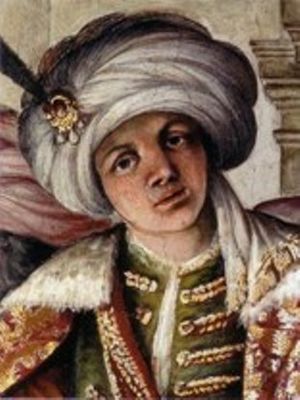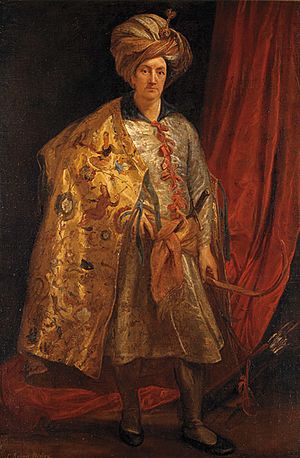Robert Shirley facts for kids
Sir Robert Shirley (born around 1581 – died July 13, 1628) was an English explorer and adventurer. He was the younger brother of Sir Anthony Shirley and Sir Thomas Shirley. Robert Shirley is famous for helping to make the Persian Safavid army stronger. He did this by training them in the British style, as requested by Shah Abbas the Great. This training was very successful. After Robert's help, the Safavid army became as strong as their main enemy, the Ottoman Empire.
Contents
Robert Shirley's Family
Robert Shirley was the third son of Sir Thomas Shirley and Anne Kempe. His family lived in Wiston, Sussex, England. He had two older brothers, Sir Thomas Shirley and Sir Anthony Shirley. He also had six sisters.
Robert Shirley's Adventures and Work
Journey to Persia
Robert Shirley first traveled to Persia in 1598. He went with his brother, Anthony. Anthony had been sent to Safavid Persia to help train the Persian army. He brought 5,000 horses to teach the Persian soldiers how to fight like the English militia. He also helped improve their cannons and other weapons.
When Anthony Shirley left Persia, Robert decided to stay. He remained in Persia with fourteen other Englishmen.
Marriage to Teresia Sampsonia
In February 1607, Robert Shirley married Sampsonia in Persia. She was a Christian Circassian lady from a noble family in Safavid Persia. After she was baptized, she added the name Teresia. She became well-known in Europe as Lady Teresia Sampsonia Shirley.
Helping the Persian Army
In 1608, Shah Abbas sent Robert Shirley on a special trip to Europe. His job was to visit leaders like James I of England and other European princes. The goal was to ask them to team up against the Ottoman Empire.
Robert's work in modernizing the Persian army was very successful. The Safavids won a big victory against the Ottomans in the Ottoman–Safavid War. This win helped Persia get a very good peace deal.

Travels in Europe
Robert Shirley first traveled to the Polish–Lithuanian Commonwealth. There, he was welcomed by King Sigismund III Vasa. In June 1608, he arrived in Germany. He received important titles like Count Palatine and Knight of the Holy Roman Empire from Emperor Rudolph II. Pope Paul V also gave him the title of Count.
From Germany, Sir Robert went to Florence and then to Rome. He arrived in Rome on September 27, 1609, with eighteen people with him. Next, he visited Milan and Genoa. From Genoa, he sailed to Spain, arriving in Barcelona in December 1609. He sent for his Persian wife, Teresia. They stayed in Spain, mostly in Madrid, until the summer of 1611.

Return to Persia and Death
In 1613, Shirley returned to Persia. He came back to Europe in 1615 and lived in Madrid. In 1615, he had a lucky meeting in the Persian desert. He met Thomas Coryate, an interesting traveler and writer from London.
Robert Shirley's third trip to Persia was in 1627. He went with Sir Dodmore Cotton, who was the first British ambassador to Persia. Sadly, soon after reaching Persia, Robert Shirley died in Qazvin, which is in modern-day Iran.
He was first buried in Qazvin. But in 1658, his wife Teresia moved his remains to Rome. She later lived in a special religious home in Rome near Santa Maria della Scala. She passed away there in 1668.
Robert Shirley in Art
You can find several paintings of Robert Shirley and his wife together. These include paintings in private collections and at Petworth House. One famous painting is by Anthony van Dyck.
Robert Shirley in Literature
The adventures of the Shirley brothers were made into a play in 1607. It was called The Travels of the Three English Brothers. It was written by John Day, William Rowley, and George Wilkins.
In 1609, a Scottish writer named Andreas Loeaechius wrote a poem praising Shirley. It was translated into English by Thomas Middleton.
See also
- García de Silva Figueroa
- Safavid dynasty
- Military history of Iran


